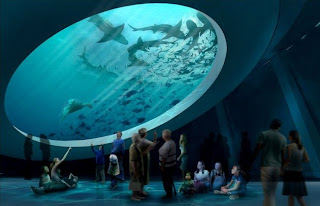Miami Science Museum envisioned as a natural wonder
 The Miami Science Museum has unveiled an ultramodern conceptual design for its planned new downtown home that wraps a series of layered outdoor terraces around a big Gulf Stream aquarium and a striking new planetarium orb overlooking Biscayne Boulevard.
The Miami Science Museum has unveiled an ultramodern conceptual design for its planned new downtown home that wraps a series of layered outdoor terraces around a big Gulf Stream aquarium and a striking new planetarium orb overlooking Biscayne Boulevard.Capping the three-level structure: a clear, teardrop-shaped canopy that would allow natural light to flow into the building and through the main aquarium tank -- and permit residents of the condo towers across Biscayne to look into the museum.
Crammed with digital technology, the $275 million project, scheduled to start construction late next year, is designed to function as an organic demonstration of green-building principles and South Florida's climate and ecology. Visitors would follow a spiral ramp leading indoors, then outside, then back inside, while traveling from the stars of the Cosmos down through the Florida wetlands to the bottom of the Gulf Stream.
Perhaps the most dazzling feature is the cone-shaped aquarium tank, 100 feet across at the top. The tank is sliced open at an angle at the bottom to allow visitors to peer up through the water toward the sky.
The building -- designed by the noted Grimshaw Architects of England, with aquarium design by Thinc of New York -- has been shaped to take full advantage of the local climate and landscape, museum officials say.
The structure would be largely open on two sides -- where it faces the planned new Museum Park on the site of the current Bicentennial Park at Biscayne Boulevard and 10th Street -- offering visitors unencumbered vistas of Biscayne Bay and the cruise-ship port while directing the prevailing easterly breezes through its expansive terraces. Solar energy would be collected in photovoltaic cells, and rainwater recycled for use in the museum.
Rain would flow through the building, triggering turbines and other gadgets and mechanisms, museum officials say.
"The building, with its focus on sustainability, will be an exhibit in its own right," said museum director Gillian Thomas. "We wanted this very strong sunshine, wind and water experience."
Indoor galleries would house, among other features, the hands-on kids' exhibits for which the museum is known, traveling science shows and a satellite of the Historical Museum of Southern Florida, Thomas said. A wildlife center, like the one in the existing museum, would be set in an outdoor garden on a second-level terrace.
The new science museum would share eight acres with a new home for the Miami Art Museum, which issued its own preliminary design -- for a canopy-like structure on the bay by the superstar Swiss firm Herzog & de Meuron -- in 2007.
(Via Miami Herald)



Comments